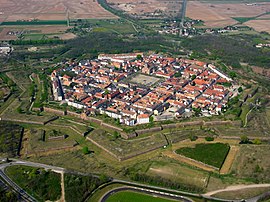Neuf-Brisach | |
|---|---|
 An aerial photograph showing the layout of the town and the way it was built as a fortification. | |
| Coordinates: 48°01′04″N 7°31′43″E / 48.0177°N 7.5285°E | |
| Country | France |
| Region | Grand Est |
| Department | Haut-Rhin |
| Arrondissement | Colmar-Ribeauvillé |
| Canton | Ensisheim |
| Government | |
| • Mayor (2020–2026) | Richard Alvarez[1] |
Area 1 | 1.33 km2 (0.51 sq mi) |
| Population (2021)[2] | 1,947 |
| • Density | 1,500/km2 (3,800/sq mi) |
| Time zone | UTC+01:00 (CET) |
| • Summer (DST) | UTC+02:00 (CEST) |
| INSEE/Postal code | 68231 /68600 |
| Elevation | 194–198 m (636–650 ft) (avg. 197 m or 646 ft) |
| 1 French Land Register data, which excludes lakes, ponds, glaciers > 1 km2 (0.386 sq mi or 247 acres) and river estuaries. | |

Neuf-Brisach (French pronunciation: [nœfbrizak] or [nøbrizak]; German: Neubreisach; Alsatian: Nei-Brisach) is a fortified town and commune of the department of Haut-Rhin in the French region of Alsace. The fortified town was intended to guard the border between France and the Holy Roman Empire and, subsequently, the German states. It was built after the Treaty of Ryswick in 1697 that resulted in France losing the town of Breisach, on the opposite bank of the Rhine. The town's name means New Breisach.
Today the town is a UNESCO World Heritage Site because of quintessential military fortifications and its testimony to the influence of Vauban on military architecture during the 17-19th centuries.[3]
- ^ "Répertoire national des élus: les maires" (in French). data.gouv.fr, Plateforme ouverte des données publiques françaises. 13 September 2022.
- ^ "Populations légales 2021" (in French). The National Institute of Statistics and Economic Studies. 28 December 2023.
- ^ "Fortifications of Vauban". UNESCO World Heritage Centre. United Nations Educational, Scientific, and Cultural Organization. Retrieved 14 November 2021.



